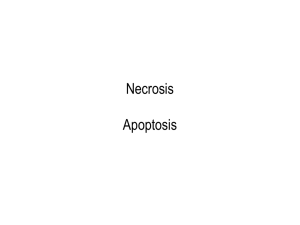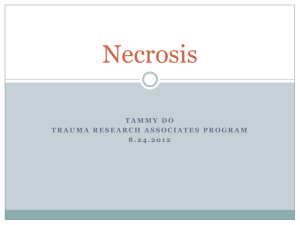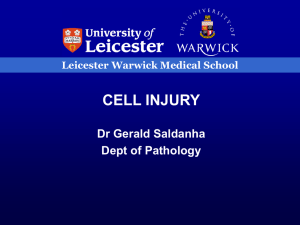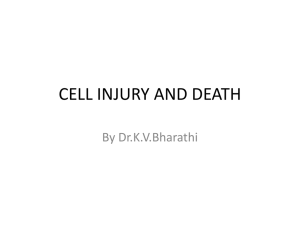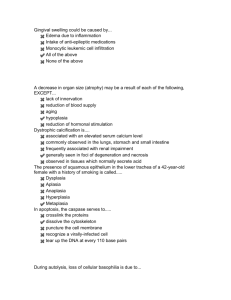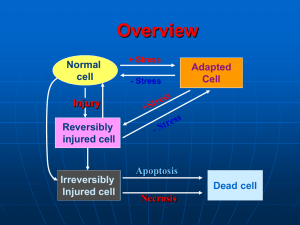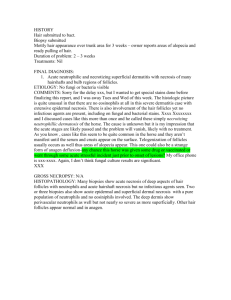cell injury: causes of cell injury, mechanisms of reversible
advertisement
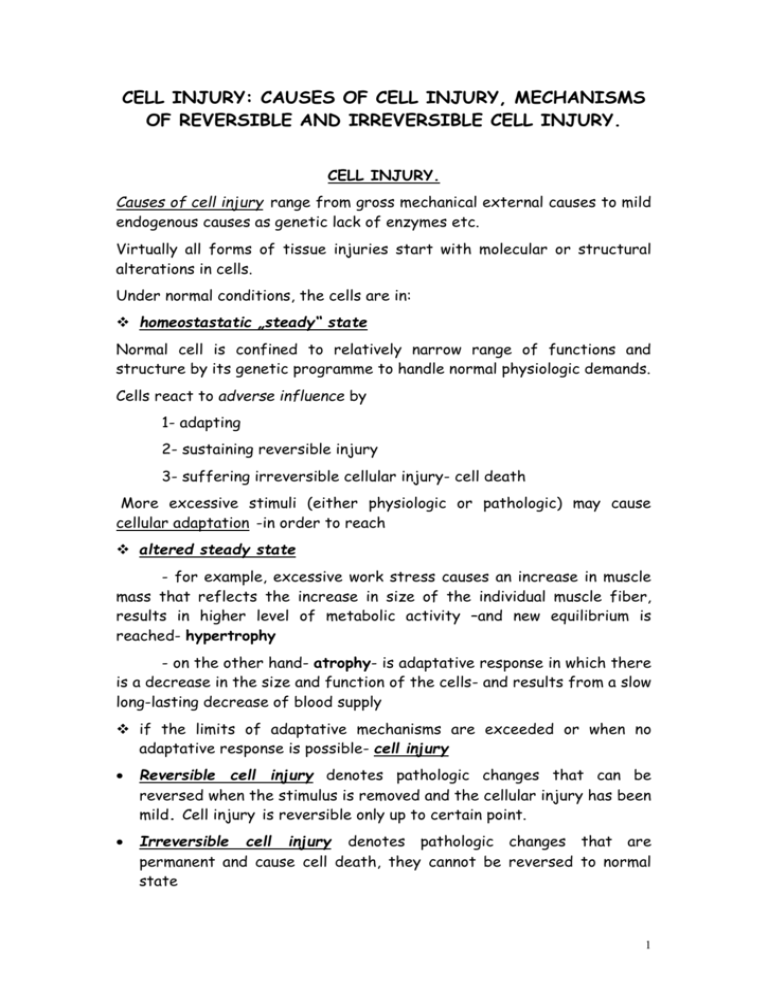
CELL INJURY: CAUSES OF CELL INJURY, MECHANISMS OF REVERSIBLE AND IRREVERSIBLE CELL INJURY. CELL INJURY. Causes of cell injury range from gross mechanical external causes to mild endogenous causes as genetic lack of enzymes etc. Virtually all forms of tissue injuries start with molecular or structural alterations in cells. Under normal conditions, the cells are in: homeostastatic „steady“ state Normal cell is confined to relatively narrow range of functions and structure by its genetic programme to handle normal physiologic demands. Cells react to adverse influence by 1- adapting 2- sustaining reversible injury 3- suffering irreversible cellular injury- cell death More excessive stimuli (either physiologic or pathologic) may cause cellular adaptation -in order to reach altered steady state - for example, excessive work stress causes an increase in muscle mass that reflects the increase in size of the individual muscle fiber, results in higher level of metabolic activity –and new equilibrium is reached- hypertrophy - on the other hand- atrophy- is adaptative response in which there is a decrease in the size and function of the cells- and results from a slow long-lasting decrease of blood supply if the limits of adaptative mechanisms are exceeded or when no adaptative response is possible- cell injury Reversible cell injury denotes pathologic changes that can be reversed when the stimulus is removed and the cellular injury has been mild. Cell injury is reversible only up to certain point. Irreversible cell injury denotes pathologic changes that are permanent and cause cell death, they cannot be reversed to normal state 1 for example: if the blood suply to heart muscles is cut off for 10-15 minutes- the myocardial cell experiences injury but it can recover to normal function, if the blood flow is cut off for longer period- the myocardial fiber dies-necrosis CAUSES OF CELL INJURY Hypoxia injury (= decrease of oxygen supply) -most common cause of cell -occurs usually as a result of ischemia (= loss of blood supply), which occurs for example when arterial flow suffers from atherosclerosis or thrombotic occlusion of arteries - most common cause of hypoxia -is due to inadequate oxygenation, for example in cardiorespiratory failure -is caused by loss of oxygen-carrying capacity of the blood, either due to anemia (decreased capacity of the blood for oxygen), or after poisoning with carbon monoxide (CO)= loss of the carrying capacity of the blood depending on the severity of hypoxia- the cell may undergo -adaptation -injury -cell death for example: -if femoral artery is narrowed (due to atherosclerotic or atherothrombotic reduction of the lumen of the affected vessel)skeletal muscles of the leg decrease in size= atrophy. This reduction in size of cell mass may achieve a new balance on the lower level, but severe and prolonged hypoxia will induce severe injury and cell death. physical agents - many forms of physical energy may give rise to cell and tissue injury, such as mechanical trauma, extremes of temperature, sudden changes in atmosphere pressure, electromagnetic energy, radiation and electric shock The most important and frequent in clinical practice are consequences of mechanical forces (traffic accidents). Changes in atmosphere pressure and hypotermia are relatively uncommon causes of injury, but hypertermia (burns) are encountered more often. Radiation injury- have also assumed importance as potential causes of widespread destruction 2 chemical agents -the list of chemicals that may cause cell and tissue injury includes -poisons-arsenic, cyanide, mercuric salts,etc -air pollutants -insecticides and herbicides -alcohol, narcotic drugs -variety of concentrations therapeutic drugs and even oxygen in high infectious agents- these agents range from the submicroscopic viruses, rickettsiae to bacteria, fungi and higher forms of parasites. immunologic reactions -immune system works in a defense against biologic agents. Immune reactions may, however cause cell injury -first- so called „anaphylactic reaction“ - to a foreign protein or drug -second- reactions to endogenous „self-antigens“ are responsible for a number of so called „ autoimmune diseases“ genetic derangements-genetic defects cause a number of diseases Genetic injury may result in severe defects and congenital malformations (Downs syndrome) or in mild derangements and errors of metabolism (lack of a distinctive enzyme ), etc. nutritional disbalances- even now nutritional errors continue to be major cause of cell injury. -protein-calorie population deficiencies- chiefly among underprivileged -deficiencies of specific vitamins -nutritional excesses have become important in cell injury among overprivileged population (excess in lipids-predispose to atherosclerosis, cause obesity, influence diabetes mellitus). GENERAL MECHANISMS OF CELL INJURY. Four intracellular systems are particularly vulnerable to cell injury: 1. maintenance of the integrity of cell membrane (upon which the osmotic homeostasis of the cell is dependent) 3 2. aerobic respiration involving oxidative phosphorylation and production of ATP (mitochondria) 3. synthesis of functional and structural proteins (Golgi) 4. preservation of the genetic apparatus of the cell (nucleus) Important aspects of cell injury: -the following factors influence severity of injury, consequences of cell injury depend both on cell and the injurious agent, and other factors 1- wide-spread effect of changes-whatever the first point of injury in the cell is - wide-range secondary effects. Above mentioned four vulnerable systems are closely related, thus injury at one of them leads to widespread secondary effects for example-impairment of aerobic respiration disrupts the energydependent sodium pump- results in loss of ionic and fluid balance- causes alterations in the intracellular content of water and ions- cell swelling 2- time factor- morphologic changes of cell injury become apparent only after some critical time. for example- light microscopic changes characteristic of cell death do not occur in the myocardium until 10-12 hours after total injury- but irreversible injury actually occurs within 20-60 minutes!! 3- cell susceptibility to injury- reactions of the cells to pathologic stimuli depend on the type of the cell. The consequences of cell injury depend on the type, state and adaptability of the cell. Important factors in the cell are: -nutritional state, hormonal status, metabolic activity and demands of the cell. How vulnerable is the cell when exposed to hypoxia? - high susceptibility-neurons (3-5 minutes) - intermediate- myocardium, hepatocytes, renal epithelial cell (20-120 minutes) - low susceptibility- fibroblasts, epidermis, skeletal muscles ( many hours) 4- reactions of the cell to pathologic stimuli depend on the type of injury, its duration, its severity, thus short ischemia may induce reversible injury, while more prolonged ischemia might lead either to cell death or to slow irreversible injury. 4 MECHANISMS OF CELL INJURY IN HYPOXIC INJURY. reversible cell injury Hypoxia first causes loss of phosphorylation in mitochondria- results in decrease of production of energy rich-ATP - loss of ATP (which is a energy source) has widespread effects on many systems in the cellfor example-heart muscle stops to contract within 60 seconds after coronary occlusion (noncontractility does not mean the cell death) the decrease in cellular ATP stimulates increase of anaerobic glycolysis= the other source how to generate energy for the cell glycogen is rapidly depleted, glycolysis results in accumulation of lactic acids - it reduces pH intracellularly - at this point, there is also early clumping of nuclear chromatin energy-dependent sodium pump slows down the activity - sodium pump keeps normally the concentration of potassium (K+) significantly higher intracellularly. Failure of active transport through the cell membrane causes that sodium (Na+) accumulates within the cell and potassium diffuses out of the cell it leads to important movement of water intracellularly= morphologic changes in reversible cell injury -cellular swelling -due to accumulation of catabolites of metabolism and water intracellularly -loss of microvilli -blebs swelling of cisternae of endoplasmic reticulum -detachment of ribosomes from the granular ER due to disruptions of energy-dependent interactions between membranes myelin figures- derived from plasma or from membranes of organelles. They are thought to results from dissociation of lipoproteins. All the above mentioned changes are reversible if oxygenation is restored. irreversible cell injury -if ischemia persists, irreversible injury develops. Irreversible injury is marked by severe mitochondrial vacuolization, extensive damage to plasma membranes, swelling of ribosomes, swelling of ribosomes. Injury 5 to lysosomal membranes leads to leakage of lysosomal enzymes into the cytoplasm, there is no universal biochemical point of no return, transitions from reversible injury to cell death. critical events for irreversible cell injury: -1- ATP depletion inability to reverse mitochondrial dysfunction (lack of phosphorylation and production of energy ) oxidative -2- Cell membrane demage -the earliest phase of irreversible injury is associated with functional and structural defects in cell membranes -great deal of evidence indicates that cell membrane damage is a central factor in the pathogenesis of irreversible injury -intact cell membranes are essencial to the maintenance of normal cell permeability and volume- loss of membrane integrity causes massive influx of calcium from the extracellular space- resulting in mitochondrial dysfunction, inhibition of intracellular enzymes, denaturation of proteins 2. CHEMICAL INJURY chemicals induce cell injury by one of two major mechanisms: 1-some chemicals act directly by chemical bindings with some critical molecules or cellular organelles for example: mercuric chloride poisoning (mercury binds directly to sulphydryl groups of cell membranes)--GIT and kidney or anticancer drugs and some antibiotic drugs also induce cell damage by direct cytotoxic effects -2-other chemicals are not biologically active but convert into reactive toxic metabolits (role of free radicals for example) 3. INJURY INDUCED BY VIRUSES viruses induce cellular changes by two general mechanisms: 1-cytolytic and cytopathic viruses cause various degrees of cellular injury and cell death 2-oncogenic viruses stimulate host cell to proliferate and may induce tumors 6 Cytopathic effects of viruses cause injury by two major mechanisms: -first is direct cytopathic effect, in which rapidly replicating virus particles interfere with some aspects of cell metabolism and cause cellular damage. Most directly cytopathic viruses have a high degree of cell specificity= viral tropism, caused by presence of membrane receptors on host cells, which interact with viral strucutres—allow to attack to the host cell—to enter the host cell and cause the injury by active reduplication of virus particles -second mechanism involves the induction of an immunological response-destruction of the cell by either antibody or cell-mediated reactions, for example the damage and death of hepatocytes caused by hepatitis B viruses are mediated by cytolysis induced by T-lymfocytes The nature of cell response to viral replication depends on the host cell and type of virus and can have several forms: 1-cell lysis-apparently due to rapid viral replication 2-some viruses can cause cytoskeletal damage (for example disruption of vimentin) 3-cell may response by formation of giant multinucleate cells, due to cell-cell fusion, for example in measles or herpes virus infection 4-some viruses infected cells develop inclusion bodies, which contain virions or viral proteins in nuclei or cytoplasm MORPHOLOGY OF CELL INJURY, NECROSIS, APOPTOSIS, INTRACELLULAR ACCUMULATIONS, PIGMENTS. Morphology of cell injury 1.- Ultrastructural changes include: cellular swelling - it is near-universal manifestation of cell injury formation of cytoplasmic blebs and distortion of microvilli deterioration of cell attachments mitochondrial changes- occur very rapidly in ischemic injury, but are delayed in some types of chemical injury. early after ischemia- swelling of mitochondrias due to changes in ions 7 small to large size amorphous densities in mitochondrias- these consist of lipids or lipid-protein complexes- dense granules rich in calcium (appear early after reperfusion) endoplasmic reticulum- changes of ER occur early after injury due to changes in ion and water regulation - detachment of ribosomes and disaggregation of polysomes -result in decrease of proteosynthesis progressive fragmentation of ER - results in formation of „myelin figures“ - derived from plasma and organelle membranes (lipoproteins) alterations of lysosomes in cell injury- generally appear later lysosomes become swollen, and after the onset of lethal injury lysosomes rupture and this event causes leakage of the lysosomal enzymes at this stage= irreversible cell injury heterophagy- is the uptake of materials from the external environment by phagocytosis. examples: phagocytosis and degradation of bacteria by leukocytes, removal of necrotic debris by macrophages, reabsorption of protein autophagy- is the phagocytosis by lysosomes of deteriorating intracellular orgtanelles, including mitochondria and endoplasmic reticulum. Autophagy is particularly pronounced in cells undergoing atrophy. Lysosomes with undigested debris- are called autophagic vacuoles and may persist within the cells as residual bodies or may be extruded from the cell 2- Light microscopic changes. Reversible changes-in classic pathology nonlethal injury to cells were termed „degenerations, dystrophies“, but today it is common to designate them „reversible injuries“ or „regressive changes“ two patterns can be recognized by light microscopy: 1-cellular swelling- appears whenever the cell is not capable of maintaining ionic and water homeostasis it is near-universal change in cell injury -is the first manifestation of cell injury -it may be sometimes difficult to appreciate with the light microscopy alone, better evident at the level of organgrossly: the organ becomes paler, it shows an increased turgor, increased weight microscopically: enlargment of cells - if water continues to accumulate-small clear vacuoles appear within the cytoplasm (=distended segment of ER) =hydropic change or vacuolar degeneration, for example: epithelial cells of renal tubuli 8 2-fatty change- is more often encountered in the cells involved in fat metabolism, such as hepatocytes - Not so universal reaction as cell swelling. - refers to any abnormal accumulation of fat within parenchymal cells -different mechanisms account for fatty change - later will be discussed -fatty change is most commonly seen in the liver, heart, muscle,etc. -although fatty change is an indicator of nonlethal injury, in many situations is encountered in cells adjacent to those that have died and undergone necrosis Cell death – is an irreversible change in the cell associated with its end We can distinguish two different types of cell death, that differ one from another in many aspects, particularly -in morphologic changes -in pathogenesis - they have different causes - different meaning and significance These are-apoptosis -necrosis TYPES OF CELL DEATH - necrosis and apoptosis APOPTOSIS -Distinctive type of cell death- occurs in physiological and embryological processes and appears to be a phenomenon whereby tissues control cell population numbers -apoptosis also occurs in pathological processes, such as inflammation and cancer, in an attempt by the body to arrest cell proliferation and tissue damage -Apoptosis- recognized as special type of cell death only recently Apoptosis- should be differentiated from common necrosis- differs both in its biochemistry and in its morphology Its designation „apoptosis“- it is a word from Greek language, which originally refers to falling of leaves from trees in the autumn Sequence of events in apoptosis 1- elevation of cellular calcium and rapid reduction of volume of the cell 2- activation of calcium-dependent enzyme endonuclease which cleaves DNA 9 3- fragmentation of DNA and marked condensation of both nucleus and cytoplasm 4- formation of apoptotic bodies- small apoptotic bodies are composed of fragments of nuclei with condensed chromatin, larger apoptotic bodies are composed of both fragments of nuclei and condesed cytoplasm with preserved organelles 5- apoptotic bodies are rapidly phagocytosed by epithelial cells in neibourghood or by macrophages - cell dying by apoptosis are recognized and phagocytosed soon after initiation of apoptosis ( role of vitronectin receptor- belongs to the family of so called integrins= adhesive cell surface and extracellular matrix proteins with important functions in cell-cell and cell-matrix interactions) Morphologic changes in apoptosis rapid volume reduction and formation of cytoplasmic blebs „shrinkage necrosis“ loss of cell - cell contacts formation of apoptotic bodies phagocytosis of apoptotic bodies by macrophages, within which they undergo hydrolytic phagocytic degradation Significance of apoptosis = programmed cell death, cell suicide, since it appears as apparently active process- it requires energy and protein synthesis. Apoptosis is dependent on gene activation and new protein synthesis. It is thought that the process is regulated by a number of apoptosis-associated genes. These include bcl-2 protein, which inhibits apoptosis and therefore extends cell survival, p-53 protein which normally stimulates apoptosis but mutated or absent favors cell survival. -it requires activation of enzyme apoptosis seems to be responsible for cell destruction in numerous physiologic events -apoptosis leads to removing of unwanted cells physiological apoptosis: occurs in a number of situations -is involved in normal tissue turnover -in hormone-induced atrophy (endometrium in menstrual cycle, mammary gland in menopause) - in developing tissues, -programmed cell destruction in embryogenesis, for example formation of digits pathological apoptosis: apoptosis may be involved in response to pathologic stimuli, 10 -such as viral infection (for example- Councilman bodies in liver cells in viral hepatitis) -tumor regression induced by chemotherapy -probably the most interesting aspect is spontaneous occurrence of apoptosis in solid tumors of various types which is now being studied very intensively - involvement of apoptosis in tumor growth NECROSIS is the most common pattern of cell death in contrast to apoptosis- necrosis may be defined as the morphologic changes that following the cell death in a living tissue or organ resulting from the progressive degradative activity of catalytic enzymes These enzymes are derived either from dying cells themselves= autolysis or from lysosomal enzymes of leukocytes, referrred to as= heterolysis -Apoptosis is a death of isolated cell/cells and typically is not associated with tissue reaction, in contrast morphologic changes of necrosis are typically caused by tissue reactivity, such as active increase in blood supply of the tissue surrounding necrosis, -infiltration of the vicinity of necrotic area by inflammatory cells, especially by leukocytes -circumscription of the necrotic focus and subsequent healing Necrosis is the sum of the morphologic changes that follow cell death in living tissue or organ. These changes result from progressive degradative activity of enzymes of lethally injured cells (autolysis and heterolysis) on one hand side- and denaturation of structural proteins two principal processes influence the changes of necrosis: 1-enzymatic digestion of the cell 2-denaturation of proteins DEAD CELL MORPHOLOGY: - cytoplasm- increased eosinophilia-attributable in part to the loss of normal cytoplasmic basophilia caused by the RNA and in part by increased binding of eosin to denatured intracytoplasmic proteins more glassy appearance of the cell cytoplasm-due mainly to the loss of glycogen particles 11 - nucleus- nuclear changes can be reversible -clumping of the chromatin with large aggregates attached to the nuclear membrane or irreversible1.- pyknosis = nucleus progressively shrinks and becomes dense mass of tightly packed chromatin 2.- karyolysis = progressive dissolution of nuclear chromatin due to action of DNAases of lysosomal origin 3.- karyorrhexis = nucleus may break up to many clumps Causes of necrosis: Identical as those of cell injury in general terms, such as mechanical, chemical, physical, infectious agents, and hypoxia/anoxia MORPHOLOGICAL TYPES OF NECROSIS 1.- COAGULATIVE NECROSIS -most common pattern of necrosis, is characteristic of hypoxic cell death macroscopic appearance: firm consistency, yellowish colour, dry appearance of the cut section -this pattern of necrosis-most commonly results from sudden severe ischemia (is encountered mostly in solid organs, such as kidney, heart, spleen, adrenal gland) pathogenesis: Coagulative necrosis implies preservation of the basic outline of coagulated cells for several days - nucleus usually disappears, but the shape of cell is preserved -Presumably, the pattern of coagulative necrosis results from severe intracellular acidosis which denaturates not only of structural proteins, but also enzymes (this block rapid proteolysis of the cell) finally, the necrotic cell breaks into fragments that are removed by phagocytosis of the cellular debris (by proteolytic enzymes of leukocytes and macrophages, immigrating into the necrotic focus) The best example of coagulative necrosis- myocardial infarction gross appearance of acute myocardial infarct changes with time fewer than 8-10 hours- ischemic area is slightly paler, hardly discernable even early infarct can be visualized by various histochemic reactions that may show depletion of oxidative enzymes from infarcted area microscopic appearance - in early acute infarction- cell swelling pyknosis, eosinophilia of cytoplasm by 18-24 hours -the infarct becomes apparent grossly - pale, more sharply circumscribed, hyperemic border- 12 microscopically: total necrosis with loss of nuclei, heavy infiltrate of leukocytes, macrophages by 3-7 days -more apparent hyperemia at the border of infarct, yellow-brown color, soft consistency end of 1st week - infarct becomes circumscribed by highly vascularized scar tissue microscopically: there is a prominent fibrovascular reaction in margins 6th week - total replacement by scar = myofibrosis 2. LIQUEFACTIVE NECROSIS -results from the rapid action of hydrolytic enzymes and occurs always when autolysis and heterolysis prevail over denaturation of proteins -characteristic of ischemic necrosis of brain, pancreas also common in bacterial lesions - due to activity of enzymes of bacterial and leukocytic origin good example of liquefactive necrosis is brain infarction gross morphology- necrotic area becomes very soft and fluidy- these changes are first detectable at about 12 hours within 2-3 day softening and discoloration become more apparent in large infarcts- there is marked swelling, tissue liquefaction results in subsequent pseudocystic degeneration no fibrous scar is formed, necrotic area changes into postmalatic pseudocyst (postnecrotic pseudocyst) =cystic space filled with debris, fluid 3. FAT NECROSIS -this refers to necrosis in adipose tissue -due to action of activated lipases most common-in acute pancreatic necrosis, in which active pancreatic enzymes cause focal necrosis of the pancreas and the adipose tissue throughout the abdomen -lipases are activated and released and destroy not only pancreatic tissue itself but also fat cells in the pancreas and also fat cells throughout the peritoneal cavity - Balser necrosis= sharply circumscribed foci of enzymatic necroses of fat tissue with shadowy outlines surrounded by a zone of inflammation the released fatty acids then complex with calcium to create calcium soaps 13 to the naked eye the necrotic foci appear opaque and chalky white or yellowish 4. CASEOUS NECROSIS -another distinctive type of necrosis that is a combination of coagulative and liquefactive necrosis. It is encountered in tuberculousis. Gross morphology: caseous necrosis appears grossly as soft, friable, whitish-gray debris resembling cheesy material—hence the term „caseous necrosis“. This appearance has been attributed to the specific lipopolysaccharides of the capsule of the agent, tuberculous bacillus (Mycobacterium tuberculosis)- the exact interactions with dead cells are not completely understood. Microscopy: Histologically, caseous necrosis appears as amorphous eosinophilic material with cell debris The caseous necrosis is surrounded by specific granulomatous inflammatory reaction (epithelioid histiocytes, giant cells of Langhans type, lymfocytes, plasmacytes). 5. FIBRINOID NECROSIS -is a type of connective tissue necrosis seen particularly in autoimmune disease collagen and smooth muscle are affected (for example- in polyarteriitis nodosa- fibrinoid necrosis affects blood vessel walls) -fibrinoid necrosis is characterized by loss of normal structure of collagen fibres -causing teh change of tinctorial features of collagen-bright eosinophilia which resembles fibrin- derived from plasmatic fibrinogen GANGRENOUS NECROSIS -it is not a distinctive type of necrosis, it is a necrosis secondary modified usually by the attack of bacterial agents. The term gangrene is commonly used in clinical practise to describe a condition when extensive tissue necrosis is complicated by bacterial infection. There are three major types of gangrene: dry gangrene wet gangrene gas gangrene -dry gangrene- necrotic tissue appears black and dry and is sharply demarcated from viable tissue 14 most commonly it occurs in extremities as a result of ischemic coagulative necrosis doe to arterial obstruction When the coagulative pattern prevails - dry gangrene develops when liquefaction is more pronounced- wet gangrene develops -wet gangrene- results from severe bacterial inection of necrotic area most commonly it occurs in the extremities due to arterial obstruction, but also in the internal organs, such as intestine- most common examplein acute suppurative appendicitis grossly- tissue is swollen, reddish-black with extensive liquefaction wet gangrene is severe complication associated with high mortality rate -gas ganrene- is a wound infection caused by Clostridium perfringens and other types of Clostridia -it is characterized by extensive necrosis and tissue destruction and production of gas by fermentative action of bacteria grossly- appearance similar as in wet gangrene with additional presence of gas in tissues crepitus- a sound that can be detected by palpation of necrotic tissues gas gangrene is associated with a high mortality rate NECROSIS and APOPTOSIS NECROSIS APOPTOSIS Stimuli hypoxia, toxins physiologic and pathologic Histology cellular swelling, coagulation single cells,chromatin necrosis, disruption of condensation, apoptotic organelles bodies DNA breakdown random, diffuse internucleosomal Mechanisms ATP depletion, membrane injury, free radical damage gene activation, endonuclease Tissue reaction inflammation no inflammation, phagocytosis of apoptotic bodies 15
